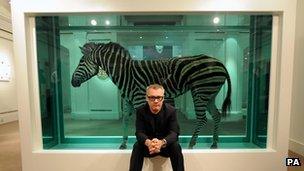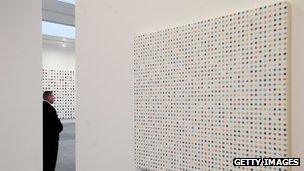Julian Spalding attacks Damien Hirst 'con art'
- Published

Hirst's work has divided art critics
Art critic and former curator Julian Spalding has predicted the conceptual work of artists like Damien Hirst will soon become "worthless".
Writing in the Independent, external, Spalding described Hirst's work as "the sub-prime of the art world" and advised owners of his work to sell quickly.
Hirst, best known for his animals in formaldehyde, has been at the forefront of the British conceptual art movement.
Arts journalist Georgina Adam said Spalding's condemnation was "unfair".
"He is probably right about later Damien Hirsts, which are more like luxury goods than art," she told the BBC.
"But Hirst's earlier work did redefine the notion of art work.
"To condemn the whole of conceptual art is unfair," she added.
An exhibition of Hirst's work opens at Tate Modern in London next week.
But Spalding told the Independent: "The emperor has nothing on. When the penny drops that these are not art, it's all going to collapse. Hirst should not be in the Tate."
Spalding said he coined the term "con art" which is "short for contemporary conceptual art and for art that cons people".
Spalding, who was director of galleries in Sheffield, Manchester and Glasgow, where he promoted artists including LS Lowry and Beryl Cook, added: "It's often been proposed, seriously, that Damien Hirst is a greater artist than Michelangelo because he had the idea for a shark in a tank whereas Michelangelo didn't have the idea for his David.

Hirst has produced over 1,000 spot paintings
"What separates Michelangelo from Hirst is that Michelangelo was an artist and Hirst isn't."
Simon Todd, from online auction website ArtNet, told the BBC he disagreed that the art bubble would soon burst: "The contemporary art market is very strong at the moment both in terms of the domestic, international and growth markets."
He said ArtNet "has been approached by financial organisations regarding arts investment despite the majority of the art funds collapsing back in 2009.
"The credit crunch seems to have made little impact and the auctions that suffered in the two years post-credit crunch are not feeling the comparative ill effects now."
Diamond-encrusted skull
Spalding's latest book, Con Art - Why You Ought to Sell Your Damien Hirst While You Can - is published next month.
Hirst first came to public attention in London in 1988 when he created the Freeze exhibition in a disused warehouse, showing his work and that of his fellow students at Goldsmiths College.
His exhibition opens at Tate Modern on 4 April and runs until 9 September.
Hirst's shark in formaldehyde - titled The Physical Impossibility of Death in the Mind of Someone Living, 1991 - will be on display, alongside other famous work including 1990's A Thousand Years, 1992's Pharmacy and a £50m diamond-encrusted skull, For the Love of God.
Hirst's sale figures dropped considerably between 2008 and 2009 although this fall coincided with the collapse of Lehman Brothers bank in the US.
Last year, one of his spot paintings - of which there are over 1,000 - sold for £1.8m.
The Tate Modern and Damien Hirst's company Science declined to comment on Spalding's claims..
Hirst's public gallery in south London, which is being developed to display his personal art collection, will open in 2014.
- Published13 March 2012
- Published12 March 2012
- Published21 November 2011